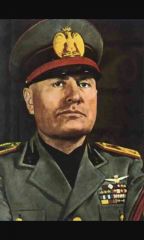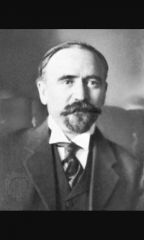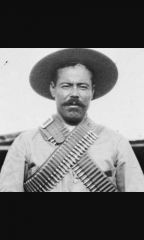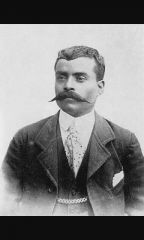![]()
![]()
![]()
Use LEFT and RIGHT arrow keys to navigate between flashcards;
Use UP and DOWN arrow keys to flip the card;
H to show hint;
A reads text to speech;
22 Cards in this Set
- Front
- Back
- 3rd side (hint)
|
Cubist Movement
|
20th-century art style; best represented by Spanish artist Pablo Picasso; rendered familiar objects as geometrical shapes.
|
|
|
|
Benito Mussolini
|
Italian fascist leader after World War I; created first fascist government (1922-1943) based on aggressive foreign policy and new nationalist glories.
|

|
|
|
Fascism
|
Political philosophy that became pre-dominant in Italy and Germany during the 1920s and 1930s; attacked weakness of democracy, corruption of capitalism; promised vigorous foreign and military programs; undertook state control of economy to reduce social friction.
|
|
|
|
Syndicalism
|
Economic and political system based on the organization of labor; imported in Latin America from European political movements; militant force in Latin American politics.
|
|
|
|
Mexican Revolution
|
Fought over a period of almost ten years from 1910; resulted in ouster of Porfirio Diaz from power; opposition forces led by Pancho Villa and Emiliano Zapata.
|
|
|
|
Porfirio Díaz
|
One of Juárez's generals; elected president off Mexico in 1876; dominated Mexican politics for 35 years; imposed strong central government.
|

|
|
|
Francisco Madero
|
(1873-1913) Moderate democratic reformer in Mexico; proposed moderate reforms in 1910; arrested by Porfirio Díaz; initiated revolution against Díaz when released from prison; temporarily gained power,but removed and assassinated in 1913
|

|
|
|
Pancho Villa
|
(1878-1923) Mexican revolutionary and military commander in northern Mexico during the Mexican Revolution; succeeded along with Emiliano Zapata in removing Díaz from power in 1911; also participated in campaigns that removed Madero and Huerta.
|

|
|
|
Emiliano Zapata
|
Mexican revolutionary and military commander of peasant guerrilla movement after 1910 centered in Morelos; succeeded along with Pancho Villa in removing Díaz from power; also participated in campaigns that removed Madero and Huerta; demanded sweeping land reform.
|

|
|
|
Victoriano Huerta
|
Attempted to reestablish centralized dictatorship in Mexico following the removal of Madero in 1913; forced from power in 1914 by Villa and Zapata.
|
|
|
|
Alvaro Obregón
|
(1880-1928) Emerged as leader of the Mexican government in 1915; elected president in 1920.
|
|
|
|
Mexican Constitution of 1917
|
Promised land reform, limited foreign ownership of key resources, guaranteed the rights of workers, and placed restrictions on clerical education; marked formal end of Mexican Revolution.
|
|
|
|
Diego Rivera
|
(1886-1957) Mexican artist of the period after the Mexican Revolution; famous for murals painted on walls of public buildings; mixed romantic images of the Indian part with Christian symbols and Marxist ideology.
|
|
|
|
José Clemente Orozoco
|
(1883-1949) Mexican muralist of the period after the Mexican Revolution; like Rivera's, his work featured romantic images of the Indian past with Christian symbols and Marxist ideology.
|
|
|
|
Cristeros
|
Conservative peasant movement in Mexico during the1920s; most active in central Mexico; attempted to halt slide toward secularism movement resulted in armed violence.
|
|
|
|
Alexander Kerensky
|
(1881-1970) Liberal revolutionary leader during the early stages of the Russian Revolution of 1917; sought development of parliamentary rule, religious freedom.
|
|
|
|
Red Army
|
Military organization constructed under leadership of Leon Trotsky, Bolshevik follower of Lenin; made use of people of humble background.
|
|
|
|
New Economic Policy
|
Initiated by Lenin in 1921; state continued to set basic economic policies, but efforts were now combined with individual initiative; policy allowed food production to recover.
|
|
|
|
Union of Soviet Socialist Republics
|
Federal system of socialist republics established in 1923 in various ethnic regions of Russia; firmly controlled by Communist party; diminished nationalities protest under Bolsheviks; dissolved 1991.
|
|
|
|
Supreme Soviet
|
Parliament of Union of Soviet Socialist Republics; elected by universal suffrage; actually controlled by Communist party; served to ratify party decisions.
|
|
|
|
Joseph Stalin
|
Successor to Lenin as head of the U.S.S.R.; strongly nationalist view of communism; represented anti-Western strain of Russian tradition; crushed opposition to his rule; established series of five-year plans to replace New Economic Policy; fostered agricultural collectivization; led U.S.S.R. through World War II; furthered cold war with western Europe and the United States; died in 1953.
|
|
|
|
Collectivization
|
Creation of large, state-run farms rather than individual holdings; allowed more efficient control over peasants, though often lowered food production; part of Stalin's economic and political planning; often adopted in other communist regimes.
|
|

